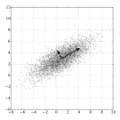Registration is an essential tool in image analysis. Deep learning based alternatives have recently become popular, achieving competitive performance at a faster speed. However, many contemporary techniques are limited to volumetric representations, despite increased popularity of 3D surface and shape data in medical image analysis. We propose a one-step registration model for 3D surfaces that internalises a lower dimensional probabilistic deformation model (PDM) using conditional variational autoencoders (CVAE). The deformations are constrained to be diffeomorphic using an exponentiation layer. The one-step registration model is benchmarked against iterative techniques, trading in a slightly lower performance in terms of shape fit for a higher compactness. We experiment with two distance metrics, Chamfer distance (CD) and Sinkhorn divergence (SD), as specific distance functions for surface data in real-world registration scenarios. The internalised deformation model is benchmarked against linear principal component analysis (PCA) achieving competitive results and improved generalisability from lower dimensions.
翻译:在图像分析中,基于深层次学习的替代方法最近变得普及,以更快的速度实现了竞争性性能。然而,许多当代技术仅限于体积表现,尽管医学图像分析中3D表面和形状数据越来越受欢迎。我们为3D表面提出了一个单步登记模型,该模型内化了低维概率变形模型(PDM),使用有条件的变异自动电解码器(CVAE)进行内化。变形受限制,使用排出层进行变异。单步登记模型以迭代技术为基准,以稍低的形状进行交易,以更紧凑的形状为条件。我们用两种距离指标(Chamfer距离(CD)和Sinkhorn差异(SD))进行实验,作为现实世界登记情景中地表数据的具体距离功能。内化变形模型以线性主要组成部分分析为基准,实现了竞争性结果,提高了从较低维度的通用性。




